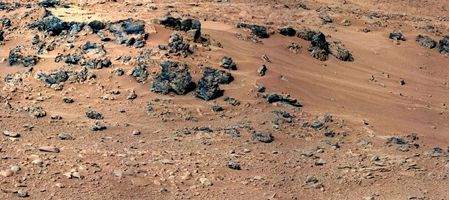NASA’s Curiosity rover is getting ready to take its first scoop of Martian soil.

The analysis of the soil sample will be one of the rover’s most crucial tasks, helping establish whether Gale Crater ever offered favorable conditions for life.
“We now have reached an important phase that will get the first solid samples into the analytical instruments in about two weeks,” says mission manager Michael Watkins.
The first step will be to test the rover’s ability to collect and process soil samples. On Wednesday, it started to prepare by using one of its wheels to scuff the soil to expose fresh material.
Next, the rover take two scoops of some soil, shake them thoroughly inside the sample-processing chambers to scrub the internal surfaces, then discard them. It will then scoop and shake a third measure of soil and place it in an observation tray for inspection by cameras mounted on the rover’s mast.
Part of the third sample will be delivered to the mineral-identifying
chemistry and mineralogy (CheMin) instrument inside the rover; and a fourth scoopful will be used to provide samples to both CheMin and to the sample analysis at Mars (SAM) instrument, which identifies chemical ingredients.
“We’re going to take a close look at the particle size distribution in the soil here to be sure it’s what we want,” says Daniel Limonadi, lead systems engineer for Curiosity’s sampling and science system. “We are being very careful with this first time using the scoop on Mars.”
The area of soil Curiosity will test and analyze measures about eight feet by 16, and has been dubbed Rocknest. While the rover’s there, it will also investigate a range of different rocks nearby, using the instruments on its mast.
After this phase, which will take a few weeks, the rover team plans to drive Curiosity about 100 yardseastward into the Glenelg area and select a rock as the first target for its hammering drill, with the aim of collecting powdered samples.






